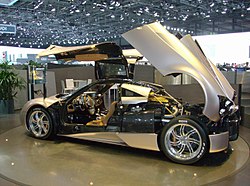The Pagani Huayra (Italian pronunciation: [ˈwai̯ra]) is an Italian mid-engined sports car produced by Pagani. Succeeding the company's previous offering, the Zonda, it costs €1,198,000 ($1,314,000). It is named after Wayra Tata, which means "God of the winds" in Quechua, the official language of the Inca Empire.[1][2] The Huayra was named "The Hypercar of the Year 2012" by Top Gear magazine and received a very positive review when tested by Richard Hammond on Top Gear. The Huayra is currently the fastest road car to go around the Top Gear Test Track, setting a time of 1:13.8, beating the previous record of 1:15.1 set by the Ariel Atom V8 in January 2011. It was used in the movie Transformers: Age of Extinction as the KSI prototype turned Decepticon Stinger.
Performance
The Huayra uses a twin-turbo, V12 engine developed by Mercedes-AMG specially for the Huayra. The Huayra's 6.0-litre engine, the M158, produces 730 metric horsepower (720 bhp (539 kW)) and 811 lb·ft (1,100 N·m) of torque. Its top speed is about 238 mph (383 km/h) and it has a rating 0–62 miles per hour (0–100 km/h) acceleration time of 3.0 seconds. Using Pirelli tires, the Pagani Huayra is capable of withstanding 1.66 g of lateral acceleration at speeds of up to 230 mph (370 km/h).The Pagani Huayra uses a seven-speed sequential gearbox and a single disc clutch. The choice not to use a dual-clutch in an oil bath was due to the increase in weight of over 70 kg (154 lb), thus negating any advantage of the faster gear changes in a double-clutch transmission.As a result, the entire transmission weighs 96 kg (212 lb).
The car is equipped with Brembo brake calipers, rotors and pads. The calipers have four pistons in front and four in the rear. The rotors are drilled carbon ceramic, 380 mm (15.0 in) in diameter and 34 mm (1.3 in) thick.
Engine
Mercedes-Benz's AMG division provides the engine of the Huayra which is hand-built by Michael Kübler.[citation needed] The 5,980 cc, twin-turbo, 60° AMG M158 V12, has been designed at the request of Pagani to reduce turbo lag and improve response, realized with smaller turbos, a different intercooler configuration and re-programmed ECU settings.Like many high-performance cars, the Huayra uses dry sump lubrication. This has several key benefits including guaranteeing oil flow even when the car is subjected to extreme lateral acceleration, preventing "oil surge" which allows the engine to operate more efficiently while the lack of an oil pan allows mounting the engine lower, lowering the car's center of gravity and improving handling. The fuel consumption of the Huayra is 10 mpg (23 l/100 km) in city and 14 mpg (17 l/100 km) in highway (EPA testing).
A water / oil heat exchanger reduces engine warm-up times on cold days and helps maintain a stable temperature for refrigerants and lubricants.
To minimize the use of pipes and fittings (and the overall weight of the vehicle), the expansion tank is mounted directly on the engine. Intercooler fins act as an expansion tank circuit at low temperatures.
The titanium exhaust system was designed and built by MHG-Fahrzeugtechnik. Hydroformed joints were developed to reduce back pressure and ensure a free flow exhaust. Titanium reduces the weight of the exhaust system while the Inconel silencers improve reliability in the most exposed parts of the exhaust at high temperatures. The entire system weighs less than 10 kg (22 lb).
Aerodynamics
Official debut
The Pagani Huayra was officially debuted online with many pictures in a press release on January 25, 2011. The official world debut was at the Geneva Auto Salon 2011 in March.EA secured the exclusive video game rights to the Pagani Huayra in 2011, available exclusively in Need for Speed titles in 2011, Shift 2: Unleashed and Need for Speed: The Run. This license expired on 31 December 2011. In 2012 it appeared in Need For Speed: Most Wanted at second place on the Most Wanted List. The Huayra also appears in Need for Speed Rivals as a racer vehicle. The Pagani Huayra also appears in the Jalopnik January DLC Car Pack for Forza Motorsport 4 along with other cars like the Ford Pinto, the Alfa Romeo Montreal and seven others. While all other cars in the pack can be purchased individually the Pagani Huayra can only be obtained by purchasing the whole pack. The Pagani Huayra was also featured in Asphalt 7: Heat, Asphalt 8: Airborne and in Forza Horizon Limited Edition, as well as CSR Racing, Assetto Corsa and Project CARS. The Pagani Huayra is also featured in Real Racing 3, Grid 2 and Grid Autosport. The Huayra is also playable in the Xbox One racing game Forza Motorsport 5, the PlayStation 3 racing game Gran Turismo 6 and the PlayStation 4 racing game Driveclub. A fictionalized version, branded the Pegassi Osiris, is included in the Ill Gotten Gains: Part 1 DLC update of Grand Theft Auto Online which was released on June 10, 2015.
The vehicle is used as an alternate mode for the Decepticon Stinger in Transformers: Age of Extinction film.


No comments:
Post a Comment